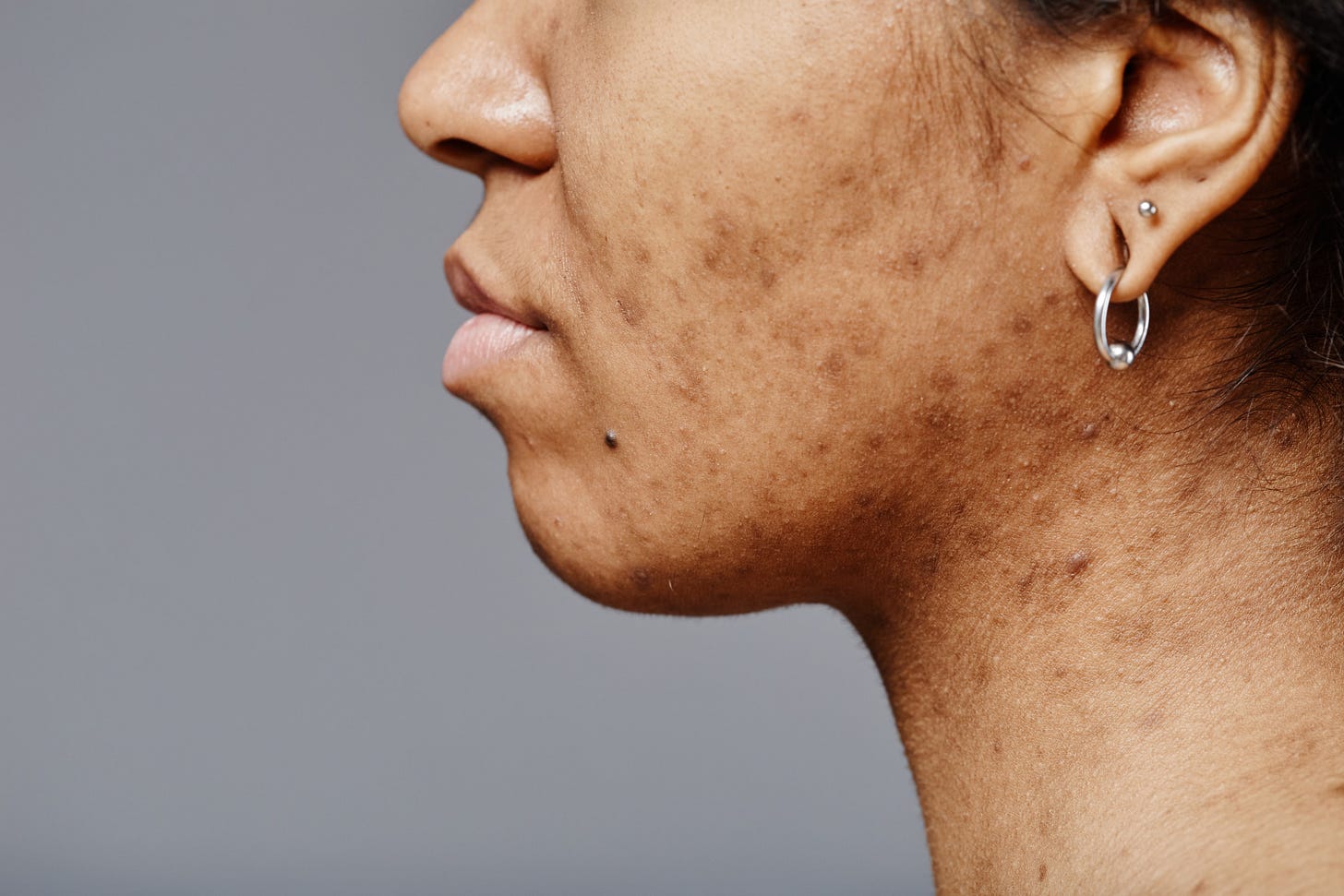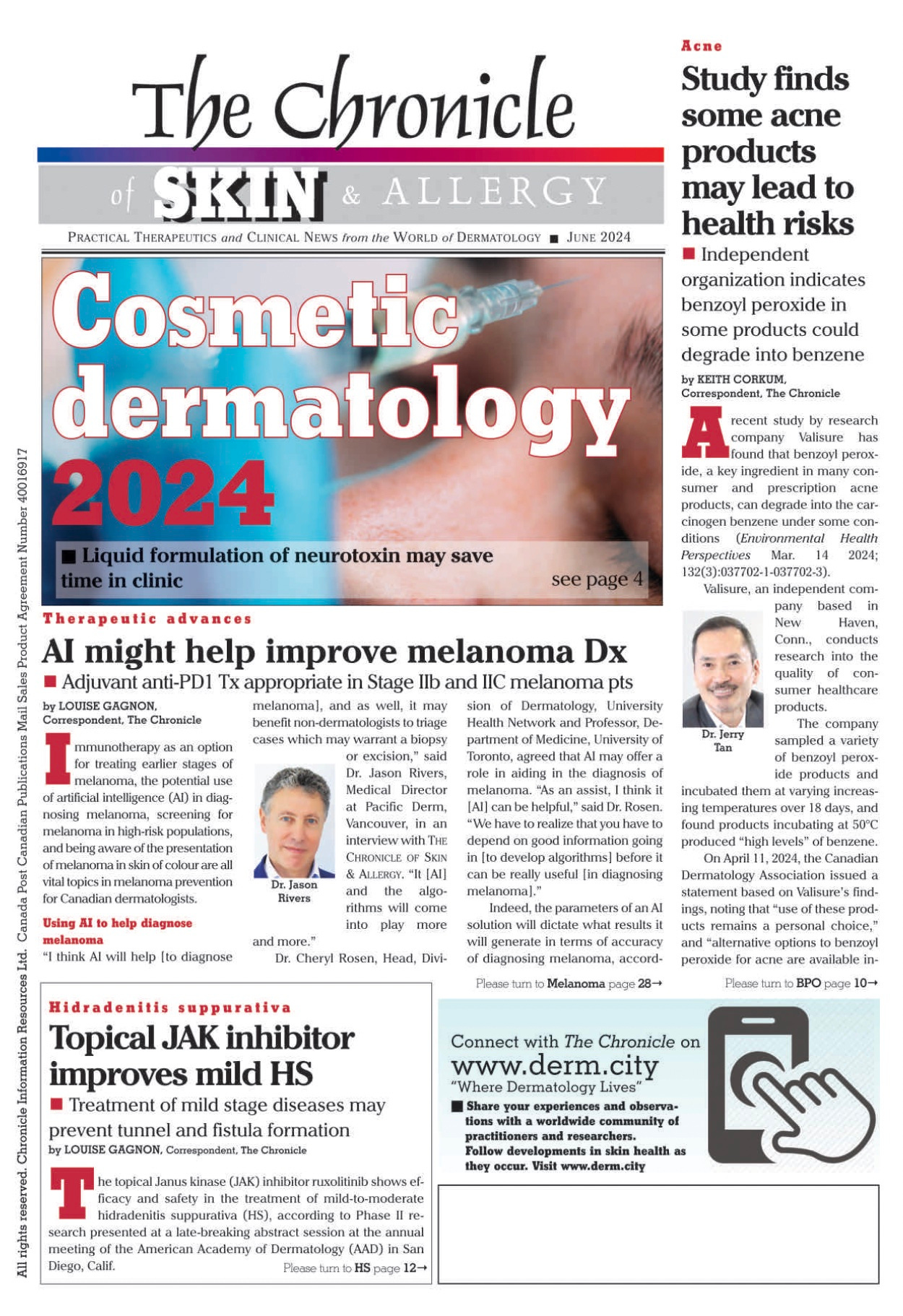Resistance to various antibiotics in acne clarified
Today's report also covers isotretinoin, familial acne history, topical clascoterone, and more (1,500 words, 7 minutes, 10 seconds)
The Focus on Acne e-newsletter is supported by an unrestricted grant from Sun Pharma Canada
Good morning, and welcome to the 18th issue of Focus on Acne, presented by Skin Spectrum Weekly. This series provides up-to-date information on developing therapies and trends in acne treatment. We appreciate your feedback and suggestions and invite you to be in touch. Please write to us at health@chronicle.org
Resistance to various antibiotics in acne clarified
A Chinese study of antibiotic resistance in acne has found that in certain regions of the world, the relatively high antibiotic resistance rates (e.g., 77% (95% CI: 62-87%) for clarithromycin in China) in C. acnes isolates may be attributed to the overuse of antibiotics in acne treatment. However, the resistance rates in C. acnes to tetracyclines, such as 2.44% (95% CI: 0.99-5.89%) for doxycycline, remain relatively low, which allows tetracyclines to continue serving as first-line antibiotics for acne treatment. Investigators also found that resistance rates to levofloxacin, erythromycin, and clindamycin significantly increased over time (p<0.05). This emphasizes the significance of the rational use of antibiotics in acne treatment.
Published in Frontiers in Microbiology, the study systematically evaluated the resistance of C. acnes to relevant antibiotics to inform the antibiotic treatment of acne.
Researchers systematically searched PubMed, the Cochrane Library, EMBASE, Web of Science, China National Knowledge Infrastructure (CNKI) and Wanfang Data from Jan. 1, 2005, to April 1, 2025, for relevant studies. From those studies, investigators collected resistance rates of C. acnes isolates to quinolones, macrolides, tetracyclines, and other relevant antibiotics. They then calculated the combined resistance rate with subgroup analyses based on different years, continents, countries, provinces in China, and drug susceptibility testing methods.
Of 8,846 studies systematically retrieved, researchers included 23, corresponding to 2,046 isolates of C. acnes. The included studies showed antibiotic resistance rates ranging from 48.17% (95% CI: 41.16-55.24%) for roxithromycin, 45.64% (95% CI: 20.49-73.22%) for clarithromycin, 43.33% (95% CI: 27.81-60.29%) for azithromycin, 29.20% (95% CI: 22.14-37.43%) for erythromycin, 22.38% (95% CI: 14.69-32.56%) for clindamycin, 5.93% (95% CI: 2.91-11.69%) for levofloxacin, 2.44% (95% CI: 0.99-5.89%) for doxycycline, 1.47% (95% CI: 0.00-85.72%) for trimethoprim-sulfamethoxazole (TMP-SMX), 1.31% (95% CI: 0.45-3.70%) for tetracycline, 0.28% (95% CI: 0.04-1.94%) for chloramphenicol, and 0.22% (95% CI: 0.03-1.89%) for minocycline.
Subgroup analysis revealed that, compared with other regions, the resistance rates to macrolides and clindamycin were higher in China. In addition, the levofloxacin, erythromycin, and clindamycin resistance rates were progressively increasing over time.
Low systemic absorption, sensitization from topical clascoterone
Phase 1 study findings show low systemic absorption of clascoterone cream 1% in patients with acne, and a favourable safety profile with no evidence of irritation or sensitization.
The findings were published in Clinical Pharmacology in Drug Development.
The paper reports the results of five phase 1 studies that assessed the pharmacokinetics (PK), safety, and skin irritation and sensitization potential of clascoterone cream 1% in healthy participants and patients with acne. Studies CB-03-01/02 (EudraCT: 2007-005064-28) and CB-03-01/04 (n=24 each) assessed PK in healthy participants. Study 171-7151-203 (n=8) assessed steady-state PK in patients with acne. Studies CB-03-01/05 (n=36) and CB-03-01/32 (n=250) assessed skin irritation and sensitization potential, respectively, in healthy participants.
Researchers found systemic exposure to clascoterone was low after repeated daily application for up to 42 days of treatment. Clascoterone was excreted in urine as conjugated esters at a ≤1% fraction of the administered dose.
Adverse events and local skin reactions were generally mild to moderate and reversible. Investigators observed no clinically relevant changes in laboratory tests and vital signs. Skin irritation and sensitization with clascoterone treatment were minimal.
Familial acne history a risk factor for severity, other factors in Chinese patients
Findings from a study conducted in a well-defined cohort of young Chinese adults from the Singapore and Malaysia Cross-Sectional Genetic Epidemiology Study (SMCGES) reinforce familial history as a key risk factor for acne onset, severity, scarring, and phenotype manifestation.
The authors of the paper, published in Dermatology, say the identification of modifiable and environmental factors associated with acne phenotypes offers valuable insights for targeted interventions to improve acne management and control.
As part of the SMCGES, researchers randomly and consecutively recruited participants from universities in Singapore and Malaysia. Investigators collected data on sociodemographic, familial medical histories of atopic diseases and acne, and lifestyle habits using a validated investigator-administered questionnaire from 6,225 young Chinese adults (mean age=22.8±5.7 years). A subset of participants underwent clinical assessment for acne severity (n=2,345), scarring grade (n=2,345), and phenotypes (n=1,191) by dermatologically trained personnel.
The authors found the prevalence of acne was 56.0%. Among acne cases (n=3,504), 38.5% had moderate-severe acne, 52.8% had scarring, 95.7% presented with blackheads or whiteheads, and 55.8% had inflammatory phenotypes. A parental history of acne emerged as the most substantial risk factor associated with all acne phenotypes. Pet ownership (Adjusted odds ratio [AOR]: 1.403, 95% Confidence level [CI]: 1.131-1.744, p<0.05) and occasional alcohol consumption (AOR: 1.328, 95% CI: 1.090-1.617, p<0.05) were associated with a higher odd for blackheads or whiteheads.
Protective factors included higher parental education levels for acne scarring (AOR: 0.650, 95% CI: 0.459-0.904; p<0.05), male gender (AOR: 0.365, 95% CI: 0.298-0.446; p<0.05) and birthplace (AOR: 0.674, 95% CI: 0.555-0.819; p < 0.05) for non-inflammatory phenotypes.

Isotretinoin/topical minocycline combo outperforms isotretinoin alone
New findings show a combination of topical minocycline gel 4% and oral isotretinoin 20 mg capsule significantly reduced inflammatory acne lesions, improved IGA scores, and had a higher success rate at week 12 than isotretinoin alone, with similar tolerability.
The findings were published in Postepy Dermatologii I Allergologii.
This prospective, randomized, comparative study included 60 patients aged 12 years or older with acne. Researchers assigned the participants to two groups. The Mino-Iso group applied minocycline gel 4% and took 20 mg isotretinoin capsules in the evening, whereas the Iso group took only 20 mg isotretinoin capsules in the evening. The study duration was 12 weeks.
At week 12, the Mino-Iso group showed a significantly greater reduction in inflammatory lesions (-88.5%) than the Iso group (-67.42%) (p<0.05). The investigator's global assessment (IGA) treatment score was statistically lower and success significantly higher in the Mino-Iso group (p<0.05 and p=0.03, respectively). Adverse events (AEs) were reported in six and four patients in the Mino-Iso and Iso groups, respectively (p=0.73), all mild and resolved during the study.
The authors conclude that the combination of minocycline gel 4% and isotretinoin can be considered a preferable treatment option for moderate-to-severe acne.

Subscribe to The Chronicle of Skin & Allergy
Established in 1995, The Chronicle of Skin & Allergy is a scientific newspaper providing news and information on practical therapeutics and clinical progress in dermatologic medicine.
To apply for a complimentary* subscription, please email health@chronicle.org with your contact information or click the link below.
If you find the contents of this newsletter interesting, please check out the Yadav on Acne podcast. It’s available at Apple iTunes, Stitcher, Spotify, or wherever you get your podcasts.







